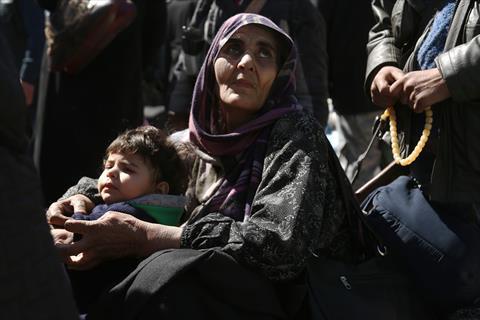You are here
Syrian army steps up strikes on capital’s last rebel enclave
By Reuters - Aug 07,2017 - Last updated at Aug 07,2017

A huge explosion sends clouds into the air after government forces reportedly carried out air and ground strikes over the rebel-held Ein Tarma district in the Eastern Ghouta region of Damascus, Syria, on Monday (Anadolu Agency photo)
AMMAN — The Syrian army stepped up shelling and air strikes on the last rebel-held enclaves in the Syrian capital on Monday, its heaviest bombardment in a two-month campaign, rebels and witnesses said.
From the strategic Qasyoun Heights that overlooks Damascus, elite units of the army pounded Jobar district, some 2km east of the Old City wall and Ein Tarma just to the south.
The army's offensive has dented a Russian-sponsored ceasefire announced two weeks ago in the Eastern Ghouta area to the east of Damascus.
Moscow has said it is negotiating with mainstream rebel groups in several areas across Syria to create new de-escalation zones and calm fighting.
Rebels and residents said Moscow had already begun deploying some military police in certain checkpoints that border the rebel-held northern Homs countryside and in southwestern Syria where "de-escalation" zones have been announced.
Residents and rescuers say the Syrian army has intensified shelling of civilian areas in the Eastern Ghouta region where rebels are holed up, many in underground tunnels, out of frustration at the lack of progress.
At least 15 civilians have been killed and scores of others injured in three days of sustained bombardment.
The UK based Syrian Observatory for Human Rights, which monitors the conflict, said at least 20 army soldiers were either killed, injured or taken prisoner in the past 24 hours, confirming rebel estimates.
Less intense shelling has hit Zamalka, Harasta and Kafr Btna, also in Eastern Ghouta. Social media videos downloaded by activists showed sorties of jets pounding areas in Ein Tarma and Jobar, with fire erupting in places and large plumes of smoke rising into the air.
Eastern Ghouta has been under opposition control for much of the six-year conflict. Jobar is in northeast Damascus and borders the Eastern Ghouta district of Ein Tarma.
The army is also using more elephant rockets — inaccurate and improvised munitions often made from gas canisters and fired on a high trajectory — insurgents said.
“The elephant rockets are not having mercy on us. We have dug tunnels and fortified our positions so they are unable to advance,” said Abu Obada Al Shami, a commander from Failaq Al Rahman, the rebel group whose fighters are drawn from the area.
The rebels, for their part, are trying to hang on to their last foothold in Damascus following the loss earlier this year of Qaboun and Barzeh districts, located north of Jobar.
Before the war began in 2011, more than half-a-million people lived in Eastern Ghouta, a sprawling mix of towns and farmland.
Two residents said Ain Terma was now a ghost town, with only a few hundred families taking shelter in basements after most former residents fled to other towns in Eastern Ghouta.
“Life is non-existent. Permanent terror and people are not coming out of their basements,” said Abdullah Al Khatib, a former electrician, who lives there with his eight-member family.
Rebels accuse the Syrian army and its Iran-backed allies of breaking the Russia-brokered truce in Eastern Ghouta to throw its full weight against Jobar and Ein Tarma.
The government has said it will abide by the truces which Russia has brokered but says it continues to target militant factions not covered by the agreement.
“This truce is a lie. The regime has not implemented it. They are shelling us without interruption using all types of weapons,” Abu Hamza, another rebel fighter said.
Related Articles
BEIRUT — Syrian government bombardment on two areas included in fragile "de-escalation zones" in the country killed four people on Thursday,
BEIRUT — Syrian government forces pounded Eastern Ghouta with air strikes on Wednesday in an effort to slice the rebel enclave in two as the
BEIRUT, Lebanon — The last rebel group fighting in Syria's Eastern Ghouta said on Monday that it was still trying to negotiate an end to the














